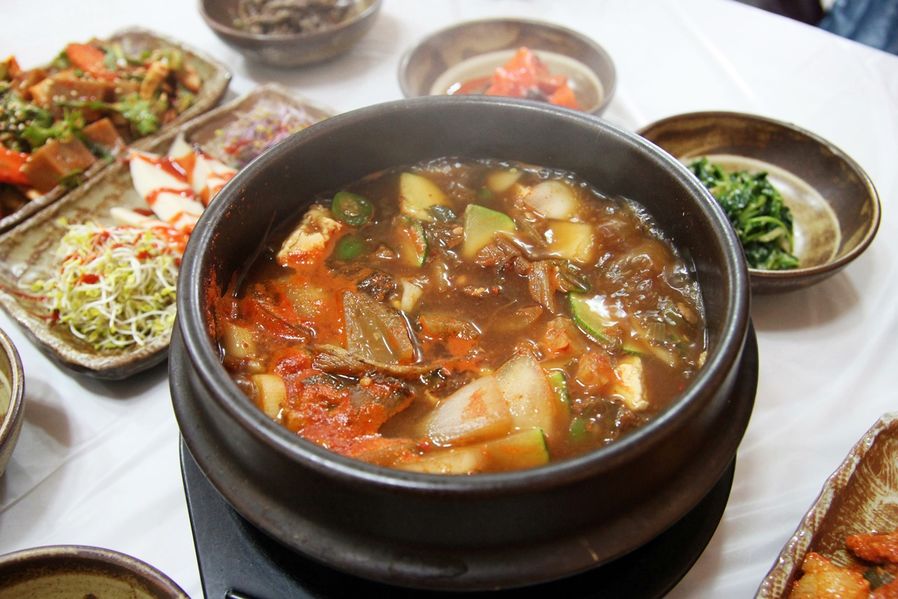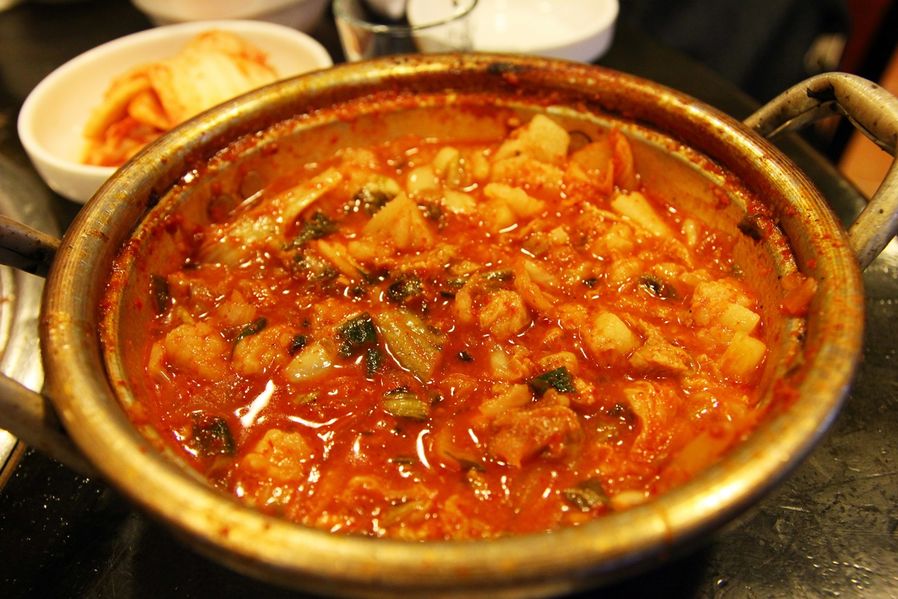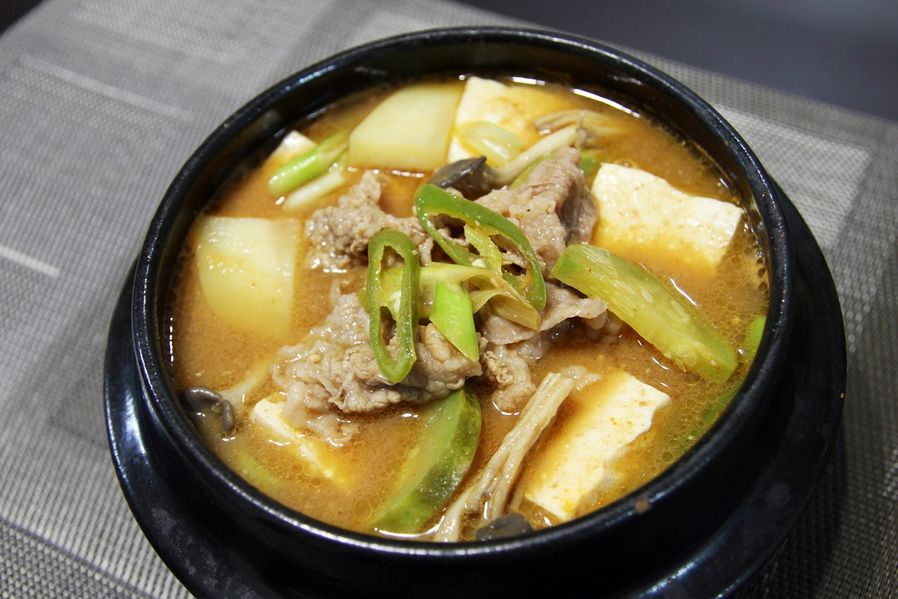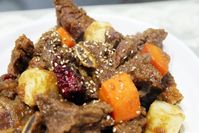1. Ingredients for Jjigae
- Primary ingredients: Meat, seafood, vegetables, etc.
- Secondary ingredients: Traditional seasoning (Gochujang paste, Deonjang, soy sauce, etc.)
2. Taste evaluation
-Spicy: ★★★☆☆
-Salty: ★★★☆☆
-Sweet: ☆☆☆☆☆
-Sour: ☆☆☆☆☆
3. Introduction to Jjigae
You’ll find at least one soup on the table in Korea.
As soup, there are two kinds, soup and Jjigae(stew). Soup is mostly liquid so it’s light while Jjigae has strong flavor of ingredients.
It is similar to soup or stew from the West and Tom Yum Kung from the East, so it is a common food for daily meal rather special.
Jjigae is originated in Koryo Dynasty era. The original Jjigae was Deonjang-jjigae that is made of Deonjang, one kind of Korean traditional pastes, and people started to cook spicy Jjigae as they imported chili pepper from Japan.
It’s not special but it was referred to Jochi when it was served to the King in Joseon Dynasty era.

You could put various ingredients in Jjigae including meat, seafood, vegetables or tofu. And you salt it with traditional sauces like Gochujang paste, Deonjang or soy sauce.
It’s more like stew than soup as it has bits of meat and vegetables, little liquid and strong flavor of sauce.
The reason Koreans enjoy Jjigae when they eat meal is because of white rice. Jjigae softens the texture of rice so they need soup like Jjigae.
There are three unique things you should know about Jjigae.
Firstly, Jjigae is served in a hot earthen pot. Earthen pot is very heat-resistant because it is made of thick ceramics.
Even when you put out the fire after it’s cooked, the bowl keeps hot temperature until you finish the meal.
You might find it dangerous at first. But it’s well known that Jjigae should be served in an earthen pot so that almost every Korean family has at least one earthen pot.
Secondly, Korean people say, “Wow, it’s so cool (Siwonhada),” even when they eat hot Jjigae. Interesting, huh? Drinking hot soul and saying it’s cool.
Cool has many meanings that are emotionally related. For one, Korean people say it’s Siwonhada(cool) when they feel like their body gets relaxed after drinking hot Jjigae soup on a very cold day.
And thirdly, Jjigae is normally served in the middle of the table for members to share. It might be called Double Dip implying a wrong manner in Western countries.
But in Korea, people think it is ‘intimate’ to share one food with family members, friends or people they’re close to even if it means all of them dip in their spoons in one pot.
But this kind of culture has been improved due to hygiene issue so you wouldn’t have to worry about it.
BUT if you are ever invited to dinner in Korea and offered to share one Jjigae, I hope you won’t misunderstand that it is ‘dirty.’ It signifies their intimacy and willingness to treat you as a family.
Aren’t you more curious about Jjigae after all the things said above?
Each Jjigae has different taste so tastes and features will be discussed in the Kinds of Jjigae section.
4. Kinds of Jjigae
There are hundreds of Jjigae depending on ingredients and sauce used.
Among them, the most popular one among Koreans and easy to eat for foreign tourists would be Kimchi Jjigae, Deonjang Jjigae, Sundubu Jjigae, Budae Jjigae and Cheonggukjang Jjigae.
Kimchi Jjigae is made of traditional Korean food called Kimchi, pork and tofu. For ripen Kimchi is used, it is spicy and sour.
Deonjang Jjigae is similar to Japanese soup called Miso as it has Deonjang, various vegetables and tofu. Deonjang has flavory and salty taste as it is made from fermented soybeans and it often stinks like cheese at the same time.
Lastly, Sundubu Jjigae uses Sundubu(soft tofu), which is much more softer than regular tofu. Plus, it has clams, various vegetables, eggs and chili powder for seasoning.
As a small amount of chili powder is used, it is not so spicy so I suggest that tourists should try this one if they want to try Jjigae for the first time.

Canon EOS 550D | f/4.0 | iso 1600 | 2011:09:30 21:00:46 | Flash did not fire, compulsory flash mode | 22mm
5. How to enjoy Jjigae even more
Jjigae is characterized by very hot and spicy sauce served in an earthen pot. You might get surprised by hot and spicy taste as you put a spoon in your mouth right after it’s served.
When it is served, you’d better spoon bits of meat and vegetables, put them on rice and eat them altogether. Then the taste and temperature should be perfect.
After you have the first spoon, try to taste the soup. You’ll feel that your head gets sweat when the spicy and hot soup flows through your mouth and throat.
That’s when Korean people say “It is cool (Siwonhada),” but what they actually mean is they feel their stomach is getting better and relaxed because of the soup.
If you ever reach to a point where you unconsciously say “Ah~~Siwonhada,” the people around would be applauding and treating you as a Korean.











